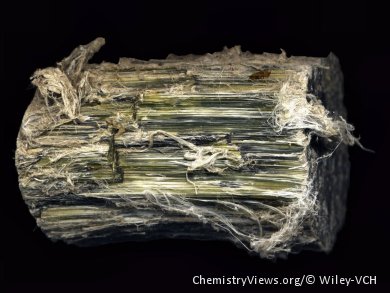Chrysotile, often called white asbestos, belongs to the serpentine group of phyllosilicates and has the composition Mg6Si4O10(OH)8. It forms monoclinic crystals of space group C2/m and is composed of layers of Mg(O,OH)6 octahedra and SiO4 tetrahedra (pictured below, left). As the dimensions of the two layers are slightly different, it results in a slight expansion of the hydroxide octahedron layer. As a consequence, bending occures and the two-layered sheet curls up, with the Mg layer on the outer side and the Si layer on the inner side (pictured below on the right) thus resulting in a (hollow) fibrous structure.

The name of this universal mineral was given by Franz von Kobell (1834) and is derived from the Greek chrysos, meaning gold, and tilos, meaning fiber; when light shines through the chrysotile fibers they look gold. The more common name of asbestos also comes from a Greek word asbestos, which means imperishable. This name refers to its properties that led to it being used for fire protection and reinforced composite materials, such as asbestos cement, brake pads, tires, in earlier times.
The use of asbestos has been banned for some years in the EU, because when it is processed and used small fibers are formed. These small fibers penetrate deeply in the lungs and cannot be removed and disposed of by macrophages, thus resulting in asbestosis. Asbestosis can lead to lung cancer and the formation of tumors in the abdominal wall (pleural mesothelioma). In many developing and emerging countries chysotile is still in use today. A less problematic substitute would be the mineral wollastonite.
The mineral on the picture was found in Thetford, Quebec, Canada.
Picture © Ekkehard Diemann, University of Bielefeld, Germany
- Chysotile is the answer to Guess the Mineral (2).
- Chrome Diopside is the answer to Guess the Mineral (1).
The next mineral quiz will be published in early August.
The lucky winners of Guess the Mineral (2) are M. Rose, Germany, and K.V.J. Murombedzi, Botswana.




